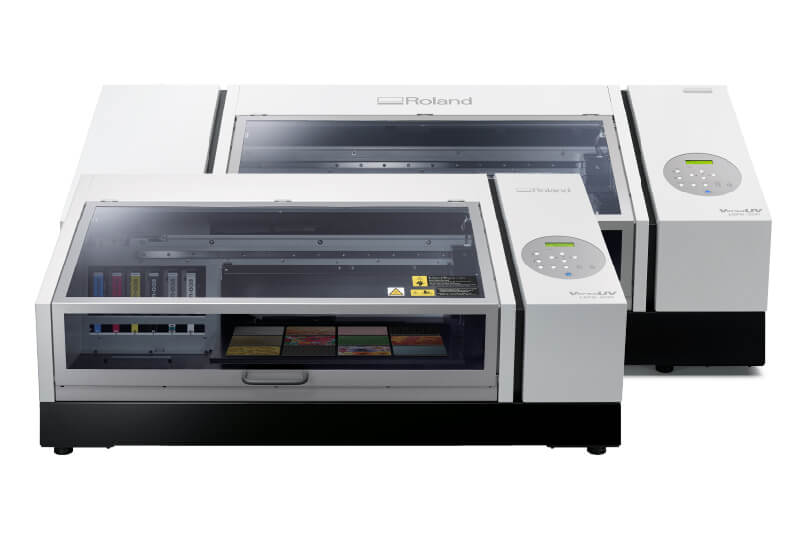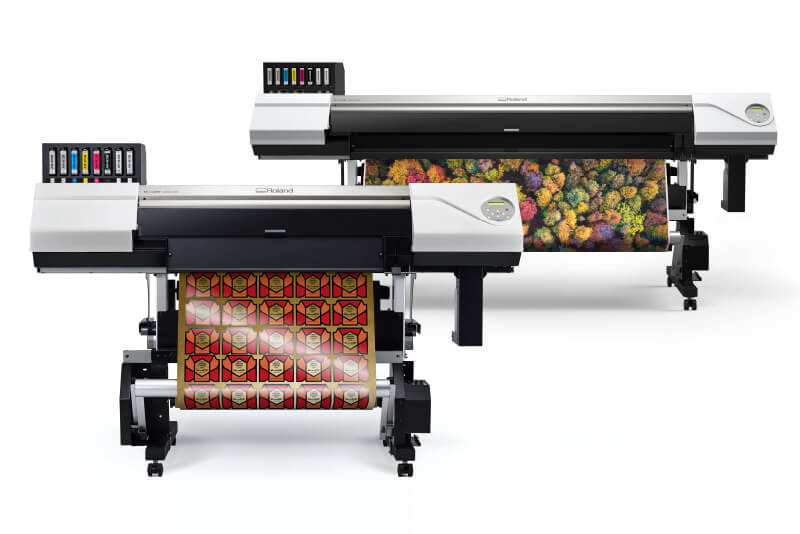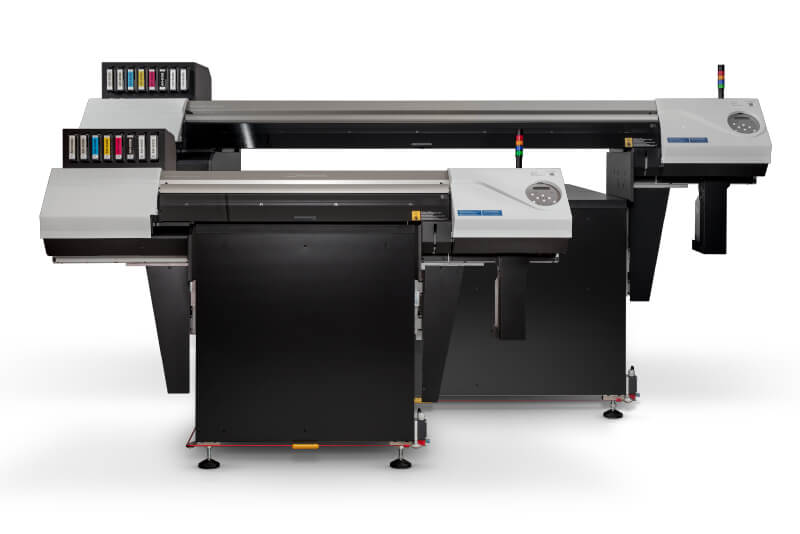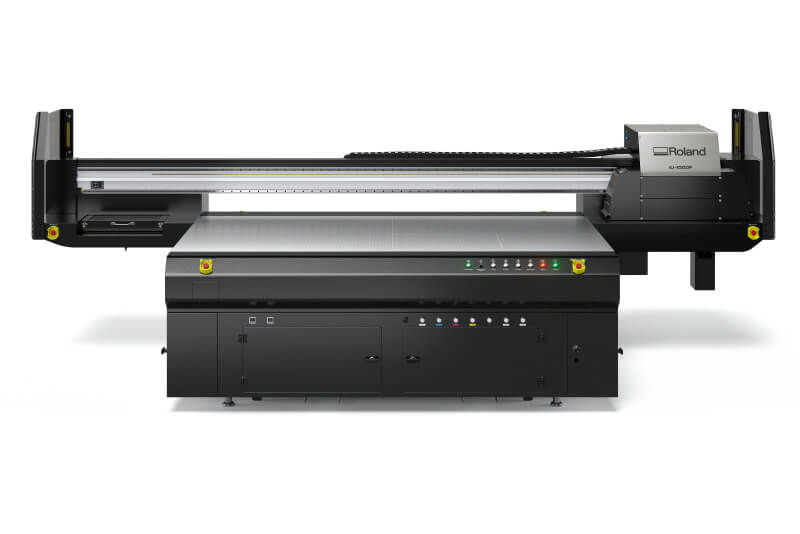UV printing technology has come a long way in the last few years. The printing heads are more precise, the production is faster, the colour gamut is wider, and the white ink has better coverage. If you’re thinking about investing in a UV printing solution, it can be difficult to know where to start with all the options available. Do you need integrated cutting functionality? Are you better off with a flatbed or a roll-to-roll printer? Should you include primer ink for better media compatibility, or double the white ink for more speed?
To help explain your options, we have created this quick overview of Roland DG’s UV printing solutions. By the end of this article, we hope you’ll have a clearer idea of which UV printer is right for your business.
Why Businesses Choose UV
Substrate Versatility
With very few exceptions, you can print directly onto almost any substrate using UV ink and ensure excellent quality and a durable result. Sign makers can print directly to boards, cutting out several stages in the application workflow; or promotional merchandise businesses can offer a huge range of branded items with logos applied directly to the surface.
Increased Productivity
With other ink technology, the lead time of any print job can be restricted by the drying or curing time of the ink. UV ink is cured instantly with UV lights built into the print head and by removing this restriction, you can significantly increase your workflow.
Gloss Ink Functionality
Gloss ink adds texture to the print output, in effect giving a certain amount of 3D printing capability. This doesn’t just add superficial highlights – it can create real business benefits, allowing sign makers to print Braille or enabling packaging companies to simulate expensive techniques such as embossing.
LEF2 Series Benchtop UV Printers

Pictured: The LEF2 Series UV Printers. Click to find out more.
If you need to print directly onto objects – big or small, individually or in batches - a benchtop UV printer is the place to start. The LEF2 Series ranges from the larger LEF2-300* down to the LEF2-200 and the LEF-12i, an entry-level UV print solution.
*The LEF2-300D is an alternative model featuring a deeper bed for printing onto taller objects
Typical uses
- Personalising small objects like keyrings, phone cases and USB sticks.
- Customising larger objects like boxes, device panels and laptops.
- Producing signage, wall décor and POP displays.
Which model should you choose?
The correct model for you is really determined by the size or volume of objects you wish to print onto, and the floorspace you have available in your premises.
If you have the space and enough customer demand, it’s generally better to invest in a larger model, giving you the ability to expand in future.
LEC2 Series Roll-to-Roll Printer/Cutters

Pictured: The LEC2 Series UV Printer/Cutters. Click to find out more.
Integrated printer/cutters have changed the way print businesses operate, offering excellent quality, productivity and (most crucially) versatility. The LEC2 Series includes the larger LEC2-640 and the compact LEC2-330*, which can be coupled with optional accessories for greater media compatibility.
Typical uses
- Premium-feel stickers with gloss highlights and fine details.
- Speciality signage and window displays with high-opacity white ink.
- Packaging prototypes with simulated press effects.
Which model should you choose?
If you already use an eco-solvent printer/cutter, there are distinct advantages to investing in a UV print and cut option like the LEC2 Series. Both models can produce the same premium quality, but the size you choose will depend on the available space and the expected customer demand.
For businesses who need greater media compatibility (creating packaging prototypes, for example), accessories are only available for the LEC2-330. These include an optional extension table for semi-rigid card stock (ET-30), and a tension bar for very thin films (TB-30).
LEC2 S-Series Flatbed UV Printers

Pictured: The LEC2 S-Series Flatbed UV Printers. Click to find out more.
The LEC2 S-Series is a flatbed, direct-printing solution for large-scale applications. Because of the high demand for this technology in a wide spectrum of industries, several models are available. Simply put, they feature the S-Series printer, fixed to either a conveyor belt or a flatbed base (available in several sizes).
Typical uses
- Personalising several objects on a larger scale than the LEF2 series.
- Customising large objects like tabletops, doors or computer cases.
- Producing large-format signage with fewer application processes.
Which model should you choose?
All models can provide a 20cm clearance between the print head and the base, so they are all suitable for large objects or thick materials (as well as standard boards). This is a highly customisable solution, designed to fit into multiple business types and as such, the ideal model for you will depend on your workflow.
We recommend speaking with a Roland DG expert to find the most suitable solution for your business.
IU-1000F Flatbed UV Printer

Pictured: The IU-1000F Flatbed UV Printer. Click to find out more.
Launched in 2021, the IU-1000F is a flatbed UV solution and Roland DG’s largest and fastest UV printer to date. It’s designed to help print companies increase their competitive advantage by significantly boosting speed and capability. Its speed alone is impressive, but the ink set featuring on-board primer, high-opacity white and super-adhesive CMYK gives it a substrate range that’s hard to beat.
Typical uses
- Producing large-format signage on an industrial scale.
- Printing panels for exhibition booths or installations.
- Printing directly to glass panes.
Why would you choose this printer?
If you need to print directly to large boards as quickly as possible, without compromising on print quality, the IU-1000F is a powerful solution. If you have space in your premises and the investment is within your reach, this device could be the key to elevating your business far beyond the competition.
Still unsure?
We have covered the main applications of these devices, but our customers continue to surprise us by doing new and unexpected things. If you have a need for direct-to-object or direct-to-substrate printing, talk to us and we’ll help you identify the best solution for your business.
